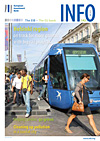Preserving the architectural heritage in the buffer zone of Cyprus’s Walled City
For almost 40 years, the Green Line, a United Nations buffer zone, has divided Cyprus’s Greek and Turkish communities. The line passes through the capital Nicosia, where the EIB is supporting efforts to revitalise the historic centre and unite the population of the island by restoring the beauty of an ancient city.
“Anyone visiting Nicosia is bound to notice a stark and painful contrast: on the one hand, they see the dynamic and thriving city centre; on the other hand, they cannot but notice the deserted neighbourhoods, dilapidated areas and ruined buildings along the so-called Green Line, which bear witness to the tragic events in our recent history”, says Eleni Mavrou, Mayor of Nicosia.
Since 1974, the Green Line has cut through the heart of one of Europe’s oldest cities, running right through the historic centre. This situation has gradually resulted in the abandonment of the area adjacent to the buffer zone and uncontrolled development towards the outskirts of the city. Nicosia Municipality has a population of about 48 000 inhabitants, while some 200 000 people live in Greater Nicosia.
Preserving the cultural heritage
Deserted houses, ruins of historic buildings and visible scars of conflict mark the area, which dates back to the 15th and 16th centuries, a period when the Venetian walls that surround the core of the Cypriot capital were built. Its long, multicultural past has given Nicosia a rich cultural and architectural heritage, from religious buildings to monuments. But these landmarks have lost their social or economic attraction for the city’s inhabitants.
“Given the conditions that have prevailed in the areas adjacent to the Green Line over the past few years, the implementation of comprehensive programmes for urban renewal is imperative,” the Mayor adds.
The EIB is supporting investment to revitalise the city’s heart with a EUR 40m loan for urban infrastructure projects in the Walled City and nearby traditional areas. The Council of Europe Development Bank (with a EUR 40m loan) and the Cypriot Government (with EU grants from the Cohesion Fund of EUR 60m) are also contributing.
“Sustainable infrastructure is among our priorities in Cyprus,” EIB Vice-President Plutarchos Sakellaris explains. “This loan is of particular importance in the current crisis as markets alone are unable to provide sufficient and appropriately priced finance for sustainable growth. We at the EIB address this market gap by increasing the volume of loans in this sector and broadening the scope of our financing”, he adds.
“It was clear from the first meetings that they would become part of our vision and aid us along the way. We found the people of the EIB helpful towards our work. The EIB has given us the opportunity to begin rejuvenating the environment,” Eleni Mavrou stresses.
Beyond beautification
“The programmes that we are currently implementing are aimed at reversing the current conditions and offering the population a tangible reassurance that these areas are safe and provide modern infrastructure that will secure a better quality of life. We have been successful on various levels, enabling us to enrich green areas, squares and open spaces. In parallel, existing buildings and the architectural heritage they embody can be properly maintained, while public infrastructure is upgraded,” Mayor Mavrou explains.
The investments are included in Nicosia’s 2010-2012 Municipal Development Plan and consist of a large number of projects which together will foster urban renewal and regeneration.
Nicosia Municipality is seeking to attract new residents, create a sense of community and boost economic activity, notably through tourism. Much of the municipality’s efforts will be devoted to fixing the local road and street network. As property owners are responsible for paving the road in front of their property up to the centre line and many buildings are vacant, many streets in Nicosia currently have no pedestrian sidewalks and where pavements do exist they are in poor condition. Often, they are also not adequately designed or built and are frequently subject to flooding during the rainy season. New urban transport schemes encourage people to walk thanks to the provision of adequate public spaces and increase road safety. Newly-built sports facilities will not only contribute to the fitness of Nicosians, but should also bring a new sense of community to the centre.
“Quite a number of projects are already being carried out and in certain areas we can already see an increased interest, especially among young people, in living there,” Mavrou points out. Revitalising the core of Nicosia and making it an attractive neighbourhood to entice people back, will help with confidence-building and, despite the buffer zone, make it a worthwhile place to live for generations to come.
“After all, such projects are designed to fulfil the needs of the area’s current residents as well as those who would like to live or work there. Ultimately, they are the driving force behind the sustainable, positive and further growth of these areas,” Mayor Mavrou concludes.

